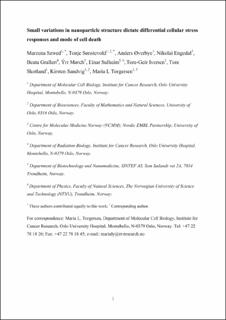Small variations in nanoparticle structure dictate differential cellular stress responses and mode of cell death
Szwed, Marzena; Sønstevold, Tonje; Øverbye, Anders; Engedal, Nikolai; Grallert, Beata; Mørch, Ýrr Asbjørg; Sulheim, Einar; Iversen, Tore Geir; Skotland, Tore; Sandvig, Kirsten; Torgersen, Maria Lyngaas
Peer reviewed, Journal article
Accepted version

Åpne
Permanent lenke
https://hdl.handle.net/11250/2649562Utgivelsesdato
2019Metadata
Vis full innførselSamlinger
- Institutt for fysikk [2695]
- Publikasjoner fra CRIStin - NTNU [38127]
Sammendrag
For optimal exploitation of nanoparticles (NPs) in biomedicine, and to predict nanotoxicity, detailed knowledge of the cellular responses to cell-bound or internalized NPs is imperative. The final outcome of NP-cell interaction is dictated by the type and magnitude of the NP insult and the cellular response. Here, this has been systematically studied by using poly(alkylcyanoacrylate) (PACA) particles differing only in their alkyl side chains; butyl (PBCA), ethylbutyl (PEBCA), or octyl (POCA), respectively. Surprisingly, these highly similar NPs induced different stress responses and modes of cell death in human cell lines. The POCA particles generally induced endoplasmic reticulum stress and apoptosis. In contrast, PBCA and PEBCA particles induced oxidative stress and lipid peroxidation depending on the level of the glutathione precursor cystine and transcription of the cystine transporter SLC7A11. The latter was induced as a protective response by the transcription factors ATF4 and Nrf2. PBCA particles strongly activated ATF4 downstream of the eIF2α kinase HRI, whereas PEBCA particles more potently induced Nrf2 antioxidant responses. Intriguingly, PBCA particles activated the cell death mechanism ferroptosis; a promising option for targeting multidrug-resistant cancers. Our findings highlight that even minor differences in NP composition can severely impact the cellular response to NPs. This may have important implications in therapeutic settings.